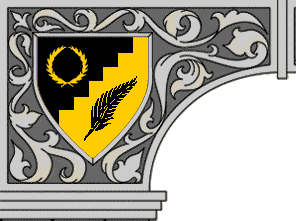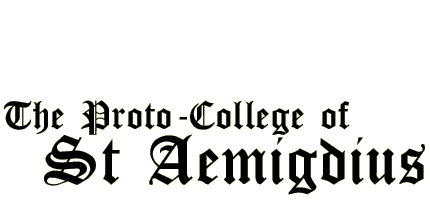

For Newcomers
Are you wondering what all this is about? Have you seen a demo and are keen for more? Are you fascinated by the Middle Ages, but want something more engaging than books and movies? Welcome to the College of St Aemigdius, a branch of the Society for Creative Anachronism (SCA) based at the Victoria University of Wellington, in New Zealand. We are a friendly group dedicated to recreating the many and divers aspects and activities of the Middle Ages and Renaissance, at our many and varied practices and events. No doubt, as a newcomer, you will have many questions - this page will hopefully answer some of those. If you can't find what you are looking for here, take a look at the resources listed at the side, and if in doubt, get in touch. We are more than happy to help, and hope new members will find the SCA as much fun as we do! Frequently Asked Questions
What is this SCA thing?Officially, the SCA is a non-profit educational and recreational organisation devoted to the study of pre-17th century European culture. Practically, that means we are a bunch of people from all walks of life who get together to recreate the better parts of the middle ages. The group was started in 1966 in California, as an informal medieval-themed birthday party. Since then it has grown to have branches all around the world with more than 50,000 people involved in a huge range of activities. SCA stands for "Society for Creative Anachronism", a name that decided on "way back when"... What is there to do in the SCA?What isn't there to do? If an activity was practiced in pre-17th century European culture, chances are there'll be a place for it in the society. A few of the things that current SCA members in Wellington are involved with include: Archery, Armouring, Blacksmithing, Brewing, Calligraphy, Chivalry, Cooking, Costuming, Dancing, Embroidery, Feasting, Gaming, Heavy Combat, Heraldry, Leatherwork, Music, Rapier Fighting, Sewing, Siege Engineering, Singing, Spinning, War, Weaving, Woodworking If you are interested in a medieval skill or craft of any kind, contact the Arts and Sciences Officer, who can talk to you about your own interests, provide information about the activities listed here, and refer you to a person knowledgeable in that skill or craft. Why are those people wearing funny clothes, and how do I get some?
Different people in the SCA recreate different time periods across Europe and the Middle East, and wear clothes (called garb) according to what was worn in that time and place. While some of it looks quite funny to the modern eye, wearing garb is one of the things that makes events so special for many people, and can make you feel as though you are really a part of the Middle Ages. In addition, some garb is considerably more flattering than modern clothing! Talking to the Chatelaine or reading this article may help you get an idea of what kinds of garb you would like to buy or recreate, and how to do it. What's with all the funny names?Almost everyone in the SCA creates a 'persona', or a fictional person that could have lived at some point in the medieval period. Note that a persona is not someone who actually lived, but rather somebody who could have lived - you can be Richard of Canterbury, but you can't call yourself Richard Lionheart! Your persona can be as simple or as detailed as you wish. Some people only go so far as selecting a name, while others create and write entire histories of the person, their family, and how events of their time period affected them. The Herald would be happy to assist in the creation of a name or persona. Start by thinking about your interests. Are you intrigued by Queen Elizabeth's court? Perhaps you've always been fascinated by the Vikings, or the late Roman empire? Maybe you want to be a Crusader, or a soldier in the Hundred Years' War? Whatever your interests, a persona can incorporate them. When you first begin attending events, one of the first questions you will be asked is "What is your name?" Many people give their real given name until they decide upon a name and persona. This practice is perfectly acceptable. In fact, some people decide to permanently keep their given name or a variant of it (a woman named Beth may use Elizabeth as her SCA name, for example). Some people have long, complex names, such as Elizabetta vidua di Giovanni Battista da Casciglioni, and others decide to keep it to a given name, or a given name and their place of origin, for example, Elizabeth of St Aemigdius. Please do not give yourself a title of any sort; in the SCA, titles are awarded to members of the Populace by royalty, for achievements in various fields within the SCA. You can adopt a coat of arms, but it's best to first chat with some knowledgeable person, such as the Herald, about how the SCA handles armory. When wishing to talk to someone whose name or title you don't know, it's always acceptable to address them as "m'lord" or "m'lady". (This is not the same as the titles "Lord" or "Lady" and, because of that, you never put their name on the end. Thus - use "Lord James" for someone who has that title, but don't use "m'lord John" for someone who does not -- just use "m'lord" or "John"). Do you really hit people with swords?Possibly the most eye-catching and exciting SCA activity is that of armed combat, when people gear up in armour and have at each other in the spirit of chivalrous knightly combat. In the interests of safety, sharp metal weapons are not used for this. SCA weapons consist of taped rattan (heavy bamboo) which has a similar mass and performance as a sword, spear or mace without the cutting edge. There are a number of important safety requirements which must be met before you can take to the field, such as minimum armour standards to protect important parts of the body (head, elbows, knees and the more vulnerable nether organs) and an awareness of what blows may be thrown and what constitutes a good blow. The best way to learn is to come along to a fighters' practice or tournament (see the Events Calendar for information on the next one). In addition, many of those who find Heavy Combat too intimidating - or are just disinterested - enjoy Rapier Combat, which is similar modern fencing, but participants use more accurate Renaissance rapiers, and following a Renaissance style. Some big events also involve "light combat", where the "heavy" fighters are supplemented by "light" fighters. The latter have similar armour requirements, but use longbow or crossbow and arrows which have special, rubber blunts for tips so they do not puncture their targets! Some major events in NZ and the rest of the world even use siege equipment such as trebuchets, ballistas and even (air-powered) cannon. Who is that guy in the shiny hat? (The SCA hierarchy and how to address them)During your first events, you'll be sure to notice people wearing various kinds of accessories, but the one which really stands out are the crowns or coronets. People who wear these are "Someone Important", as they are or may have been Royalty. If in doubt of their rank, address them as "Your Excellency". The Nobility entitled to wear crowns or coronets include Kings, Queens, Princes, Princesses, Dukes, Duchesses, Counts, Countesses, Viscounts, Viscountesses, Barons, Baronesses, Court Barons and Court Baronesses.
Don't worry too much about all these titles - if you address people politely as "m'lord" or "m'lady", no-one can fault you. Are you guys all a bunch of geeks and crazies?Geeks? Some of us would describe themselves as geeks. Overall, however, one of the strengths of the SCA is the countless different kinds of people who are involved. Accountants, architects, computer geeks, geologists, historians, lawyers, musicians, plumbers, students, teachers, technicians... the diversity of medieval life means that just about everybody can find a place in the SCA, and you will meet all sorts of interesting and wonderful people at our practices and events. Crazy? Well, yes, I suppose we are a little crazy. Still, we'd like to think we're no more crazy than people who spend their weekends playing golf or getting drunk at nightclubs - and we have more fun! Isn't this expensive?Like any hobby, the SCA can be expensive. It doesn't have to be, however - many of our members are students, who can't afford to spend a lot of money on their hobbies and interests. Going to a feast, for example, is often cheaper than going out for dinner, and you'll get better food in larger quantities! In addition, the SCA teaches and encourages people to make things themselves, and this saves a lot of money. There are many websites around that give you tips on how to recreate Medieval life without spending a fortune, such as The SCA without Breaking the Bank. Does it take a lot of time?Again, it can, but it doesn't have to. Another great thing about the SCA is that you can choose the level of your involvement, and it's fine to keep things low-key. There are things that will be time consuming - such as making garb - but there are many shortcuts you can take. And if things become too busy for you to keep playing in the SCA, most people understand that your family and mundane life come first. Ok, I'm hooked. How do I get started?Simply show up to any of our meetings, events, classes, or demonstrations! Check out the Events Calendar to see when the next one is. Non-members are very welcome to attend any of our events, though we'd encourage you to become a member if you do decide you're here to stay. This helps support our efforts and enables you to hold an office if you should want to! If you just want to attend an SCA event, the only requirements are that you:
If you are thinking of attending a formal event, email the Chatelaine. Who can I talk to if I need help?Your friendly Chatelaine is here to help. From "how do I make my first set of garb?" to "what do I need to bring to an event?", the Chatelaine is a valuable resource in helping you get started. The Chatelaine also has access to the hire garb, which is available for use by people new to the society. Email the Chatelaine.
|
|||||
| [ Home ] . [ What's on? ] . [ Regnum/Contacts ]. [ Council Minutes ] . [ Mailing Lists ] . [ Newcomers ] . [ Gallery ]
[ Shire of Darton ]
|

